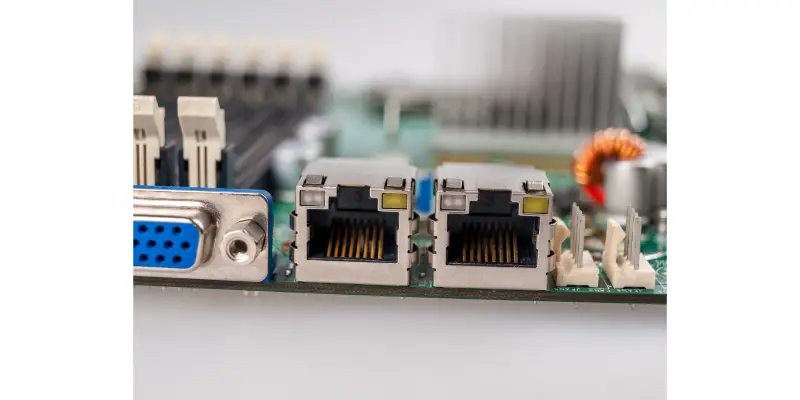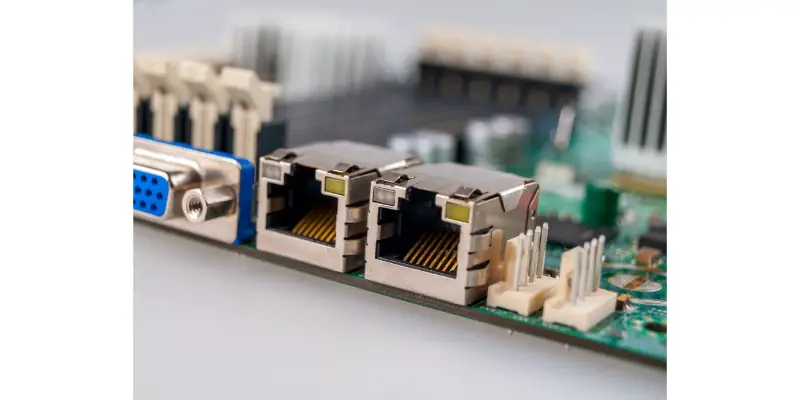Disclaimer: This post may contain affiliate links, meaning we get a small commission if you make a purchase through our links, at no cost to you. For more information, please visit our Disclaimer Page.
Why would a motherboard have more than one Ethernet port?
Motherboards having two Ethernet ports/LANs enable you to share web connection, documents, and even a printer with computers in proximity. Two Ethernet ports allow you to interconnect computers within a small area without using a router. This means that your laptop will function as a middleware.
Table of Contents
What Is an Ethernet Port?
An Ethernet socket/port is a slot on the computer’s web equipment where you can plug the Ethernet cables. Its primary purpose is to connect cabled network equipment in a cosmopolitan domain network, also known as (MAN), Ethernet LAN, or (WAN), also known as Wide Area Network.
These ports are normally on the back or side of a computer. Desktop computers have them on the CPU block, while laptops have them at the back or side depending on the computer’s model.
A router normally has multiple Ethernet ports to serve several wired hardware on a network. This also applies to other web equipment like modems and hubs. Ethernet ports normally accept cables that have RJ-45 plug.
When all the ports are occupied, you can use Wi-Fi as a substitute to using such cables as it does away with the necessity for both the port and cable.
An integrated Ethernet port is included in many desktops to facilitate for the gadget to be connected to the cabled network. The integral Ethernet port on computers is attached to its internal Ethernet web adapter known as an Ethernet card hooked up to the motherboard.
Laptops normally have an Ethernet port to their connection to the non-wired network.
What Is the Point of Having Two Ethernet Ports on a Motherboard?
Normally, one can be used to plug into a middleware or switch to access the internet. A wired NIC, also known as Ethernet Network Interface Card, is normally used with Local Area Networks (LAN).
For motherboards with a gaming level and incorporating both the Intel NIC and Killer NIC, users have the freedom to choose what will work best for them.
Various motherboards having two NICs can match them hence doubling the web throughout by applying the two on the same web. This means that a computer user using the computer for gaming can have an ultimate gaming experience.
Having two Ethernet ports also enables you to connect one of the NICs to internet connectivity and the other to an intranet. In this manner, an internet site can supply pages to the internet and at the same time obtain information from a directory server on a non-public network. This is especially where the directory server has an indirect connection to the internet connectivity.
With two network ports, your web connectivity is doubled, and the multiplier continues to go up with every port added. That means two Ethernet ports will allow you to double your connectivity. This is called double teaming.
For example, if a single port can transfer data up to 0.9 GB/s to each IP address, it would be enough for a home setting where no data is required for transfer. However, if the transfer data exceeds this range and to more than one address, an aggregate of the two ports would come in handy in making the transfers.
Therefore, the two ports are great for servers that are committed to serving more than one client at the same time. Doubling the LAN function enables the motherboard to join the connections to become a single connection.
The single connection then operates as a one-unit connection for twice the transmission bandwidth, making the data connection more reliable and efficient.
Since the ports are independent, they can be subjected to exclusive networks. This is extremely useful and is the manner in which gateways and firewalls work.
The networks can be segregated from the others individually, and the device determines what data is “bridged” across the networks.
Having two Ethernet ports is a substantial backup. Having a single network port and it malfunctions, you are done. With the extra port, you can still operate at a lower capacity.
Despite being with one port linked, the functionality should be restored with just a move of the cable to the other port.
Having two Ethernet ports increases throughput and provides some level of redundancy and latency in some solutions. You can use Ethernet inside your computer’s tower to run the home media server to multiple consumer electronics in use around the house.
What Can You Do with Two Ethernet Ports?
Use either of the Ethernet ports to access the internet
You can use one port to access the internet by connecting to a router or a switch. You can use them interchangeably, as one can act as backup for the other if one port experiences a malfunction.
Suitable for computer gaming requirements
With gaming-level motherboards incorporating the Intel NIC and Killer NIC, users can choose what is suitable for them because one may have Qualify of service (QoS) settings supporting gaming while the other may not.
Duplicate network productivity
You can use motherboards with two NICs to couple them to duplicate the network productiveness by applying both on the same web. You can connect one to the main internet connection and the other to the Wi-Fi router. This eliminates switches and offers more connectivity.
Use as a Linux
With two Ethernet ports, the system can be used as a Linux by connecting to your ISP’s device with one NIC as the Wide Area Network and connecting the other to a switch which you then connect to other systems being a LAN connection.
Access databases on an Intranet
You can also use one port to connect to an intranet and then connect the other to an internet connection. In this manner, an internet site can supply pages to the internet and obtain information from the database host on the intranet. The database host has an indirect internet connection.
Transfer data to other computers
You can also use the two ports by using one to receive/obtain data information from the internet. The other can transmit it out to other systems, hence creating a network without using several Ethernet connections.
Create a wireless network
You can also use one port to connect to Wi-Fi middleware, and the other plugged into the prime web connection hence eliminating switches. This proves to be a logical alternative for putting together a wireless network.
Split the needs of the computer
You can also use ports to split the computer’s needs as they can do so. Each code you feed into a laptop or computer can be converted into Ethernet adaptors with a bit of moderation. Also, the speed of your network could increase if you use Ethernet adaptors, ensuring that your Wi-Fi connection is up to hold the links.
Establish a hardware firewall with your computer
These ports can also be used when you need to establish the computer as a go-between server or as a hardware firewall; that is, the PC will be connecting the internet and the other PCs.
Conclusion
LANs can keep connections with more LANs over dedicated lines, dedicated services, or over the internet using virtual private network technical knowledge.
Controlled by how the links are vested and secured and the distance in question, such connected LANs can be categorized as Wide Area Network (WAN) or Metropolitan Area Network (MAN).


